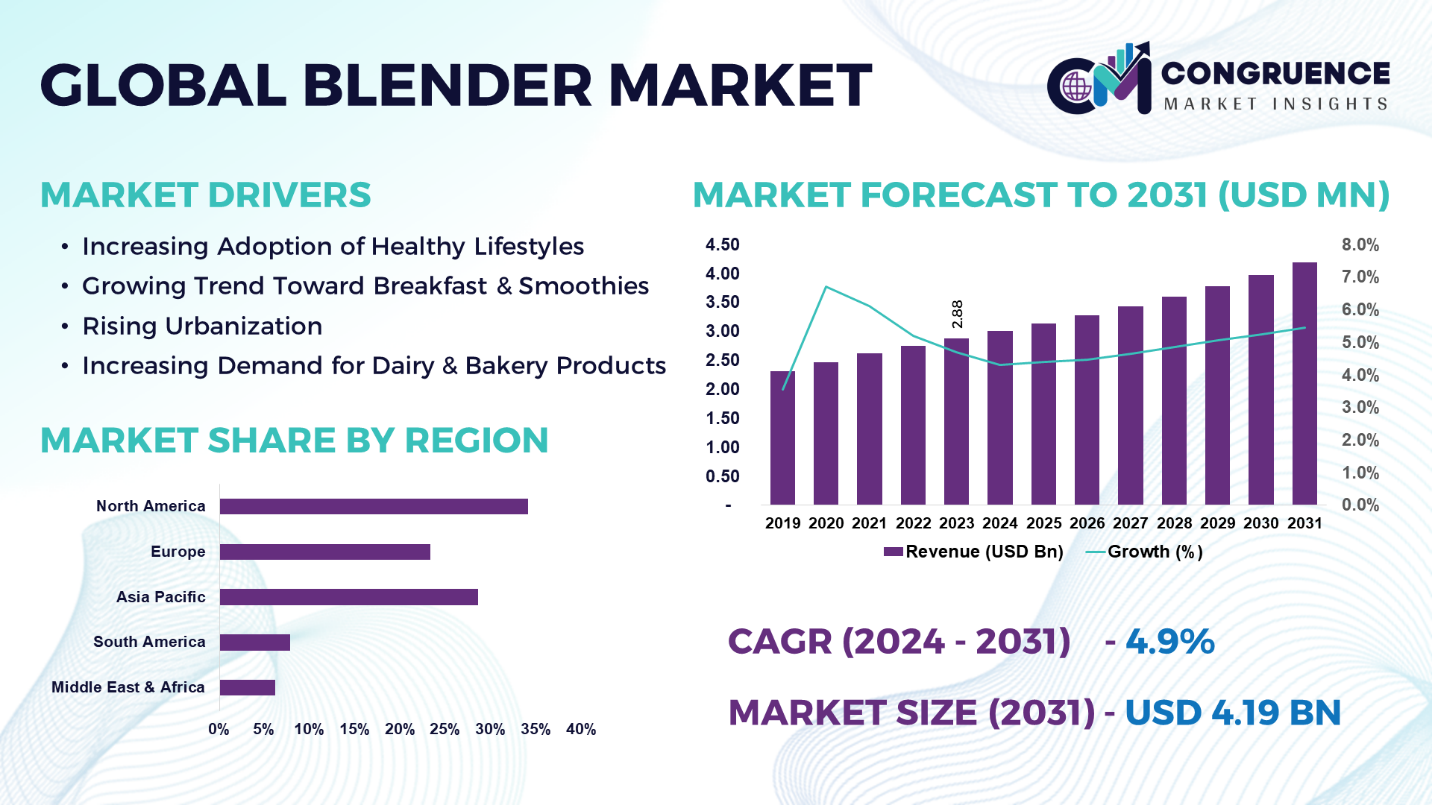Reports
Blender Market Size and Forecast 2024 to 2031
The Global Blender Market was valued at USD 2.88 Billion in 2023 and is anticipated to reach a value of USD 4.19 Billion by 2031 expanding at a CAGR of 4.9% between 2024 and 2031.

To learn more about this report, request a free sample copy
A blender is an essential kitchen equipment used to chop, mix, and emulsify food into a paste that is used in soups, pasta, sauces, smoothies, juices and so on. In addition to mixing, this equipment may cut, grind and homogenize food and thus present smooth negatively desired textures as may be necessary in several cuisines. A blender is a tool comprising of sharp cutting blades, fixed to a motor that turns at different rpms to make a suitable texture and texture. The blender market has also been segmented into many types that have been created specifically for use in hand held mixers, counter top mixers, cafe /individual blenders, juicer mixers and so on. Countertop blenders are more popular blenders being used in homes or businesses for blending large amounts of ingredients albeit personal blenders which are commonly used by selective clients for blending food items such as smoothies or proteins in single blending containers.
These are some of the factors that have made the industry behave in such a way for a blender in the past years. For instance, the increase in the popularity of healthy lifestyles and the new trend of eating processed meals and beverages have created additional demand. This has been in the course of daily addition of smoothies and other nutrient rich beverages and as a result of urbanization. Also, blender plays a crucial role in business societies that contain liquids and thickeners like dairy businesses and baking firms.
Blender Market Major Driving Forces
· Increasing Adoption of Healthy Lifestyles: Blender is one area that supermarkets have been forced to undertake investment due to growing health conscious clients. Technological advancement brings new multi-media technology that exposes people to information on the importance of eating healthy foods since there is a risk of people getting obese, diabetics, and cardiovascular diseases. This is especially the case given that consumers are making attempts to add healthy foods to their meals; thus use of blenders is on the rise. They are much used today as solutions for preparing tasty new healthy drinks like smoothies and juices because it is very easy to incorporate requisite foods including fruits, and vegetables among other health-contributing ingredients in peoples’ diets.
· Growing Trend Toward Breakfast & Smoothies: The fame for smoothies and similar other high nutritional value drinks has gone up overnight and hence has boosted blender sales. Consumers are using private labels to have increased control over the ingredients and nutrients in value-added foods including breakfast foods and beverages. Convenience, health and energy are best served in breakfast meals and milkshakes for the juice pressed society of today. This trend is most seen with the millennials and the younger working population where many are in a hurry, and are conscious of what they eat.
· Rising Urbanization: Another big driver that is driving the blender industry is the growth in the rates of urbanization. During the process of a population moving from one area to another, there is a need to have appliances that can function in small kitchens and be easy to store especially when the occupancy is high. This is accompanied by blenders that provide such characteristics of those blenders as it enhances the advertisement of such products among various urban families.
· Increasing Demand for Dairy & Bakery Products: Blender is used in the production and consumption of dairy and bakery products among other food products that in the recent past have been registering high levels of growth thus leading to high demand for blenders. These products need blenders for combining batters and doughs and emulsifying some ingredients found in foods. Customers have realized the need for efficient and effective blending equipment for use in commercial and household businesses such as blending milkshakes, yogurts and baked products.
Blender Market Key Opportunities
· Technological Advancements: New technologies represent considerable potential for the blender industry. The latest options such as the smart mix technology, auto control option and application compatibility are pushing the customer’s experience to newer heights. Powerful, quiet, self-cleaning ones with multiple speeds are used by healthy and fast-food consumers because of their convenience. In addition, blenders capable of processing frozen and hard mixtures and making emulsions as well as hot blends have boosted their demand. These advancements are in line with the customer's need to have small appliances that can perform several functions that may ease meal preparation but yield precise results.
· Online Retail and E-commerce Growth: Blender consumers are no longer limited to purchasing blenders through store-based retail outlets with internet retail and electronic commerce outlets replacing the traditional stores. The product is more diversified and described in an extensive manner moving with competitive prices and even customers’ reviews in e-commerce. Purchasing goods and services online makes it easier with home delivery which is welcomed by the consuming public, especially the young ones known as the millennials and Generation Z. However, communication with people and referring to the special functions of a blender are performed with the help of digital marketing and social platforms. There are good reasons for companies to support e-tailing, such as seasonal sales and volume discounts, product bundles and easy return policies which increase sales, thus becoming a profitable development outlet for manufacturers.
· Rising Demand for Energy-efficient Kitchen Appliances: The emphasis on sustainability in every country has presented opportunities for developing blender kitchen appliances that are energy efficient. Ecofriendly blenders use less power and at the same time lead to increased consciousness amongst consumers about the environment. Continuation of regulatory standards and governmental inducements to the energy-saving gadgets fosters more development in this segment. Manufacturers may incorporate energy efficient motors, friendly materials in the blenders as well as smart energy systems in the blender models. Stressing energy efficiency as one of the major components in marketing can make it possible to attract those consumers who are more concerned with environmental issues and, therefore, create a competitive advantage in the market.
Blender Market Key Trends
· The increasing awareness regarding importance of portioned meals and benefits of using fresh homemade blended foods is one of the key drivers of the blender market. A blender is useful in preparing new and fresh juices in meals such as smoothies, soups and pure food meals that consist of nutrients that are not processed. This development comes hand in hand with current global trends of healthy eating.
· The blender technology in use in the provision of general user experience is changing with the evolution of technology. Intelligent command, link with the smartphone, an improved engine, and advanced blade technologies lead to improved blending precision and flexibility. Automatic cleaning features, noise control, and settings activate consumer’s need for convenient products turning blenders into essential household appliances.
· The global rise in manufacturing and production of dairy and pastry is foreseen to further boost the consumption of industrial and commercial blenders. many appliances are useful in mixing, emulsification, and matching of effort since homogenization is critical in making all products to have the same consistency to meet customers’ needs and expectations in different industries.
· Blender often witnesses a rise in sales of its products as new popular cuisine trends such as smoothie bowls, meal replacement shakes, and homemade sauces continue to garner popularity from customers. Social networks that post bright, healthy recipe application meals extend this trend by encouraging consumers to reproduce them at home.
· The advancement of healthy living has given rise to more popularity of portable and small blender. Urban consumers, especially those with limited kitchen storage space, appreciate the portability of these appliances for that reason. These devices are ideal for creating on the go drinks and limited quantity concoctions.
· The use of e-commerce channels has grown rapidly and it is changing the blenders selling market. Advertising entails convenience and competitive prices, product information, and user information on the product qualify the purchase as informed. Seasonal sales and grouped offers add to the inducement, hence, ensuring that internet buying serves as the key driver of growth.
Region-wise Market Insights
North America accounted for the largest market share at 34.1% in 2023 whereas, Asia Pacific is expected to register the fastest growth, expanding at a CAGR of 5.5% between 2024 and 2031.

To learn more about this report, request a free sample copy
At present, the largest blender consumption region is North America because of their high purchasing capacity and potential blender-customers and their focus on growth and development. Market expansion is prompted by high demand for energy efficiency and technological meaning in appliances. The increasing trend in portable blenders makes a lot of sense to the current market trend of customers wanting to prepare healthy meals and also convenience as they move around. Moreover, the nature of having more than one key competitor offers a regular source of innovation in products making the competitive environment of this market better. The people in the region also embrace change and thanks to the growing awareness of how sustainable living is, the demand for energy efficient blenders is propelled. However, the European market of blenders has different characteristics, being focused on quality, durability and performance. Manufacturers located in the region have been known to offer quality goods that meet the new emerging trends of the discriminating consumer market. The region’s focus on a sustainable environment will promote innovations in energy-efficient as well as recyclable blender models. Additionally, the trend towards health and fitness, coupled with an increasing focus on home meal preparation and consumption of fresh produce such as smoothies which require meal procurement with blenders, is also expected to fuel blender growth in major economies including Germany, France and the United Kingdom.
The growing population density of the region and increasing affordability is fueling the blender market in Asia-Pacific. New technological items available, rising e- commerce activity, and shifting life styles have all acted as key drivers to demand growth in the blender sector. Players from the East like China, India, and Japan have reported higher market frequencies because customers know the importance of convenience and health. There are still so many people middle class and the growth of knowledge concerning kitchen appliances also promotes the growth of the market.
Blenders are gradually finding their way in the Middle East and Africa due to factors such as increased uptake of convenience foods due to urbanization, and increase in disposable income. The factors that are currently fueling the market growth include expanded service of world brands and concentration on enhancing kitchen areas. In contrast, blender sales have benefited from the economy in Latin America because of ingredients such as increasing middle-class consumers and popular focus on health and fitness. Cost sensitivity in Latin America viewers and listeners can be attributed to continued stable growth in the appliance market for reasonably priced but efficient appliances.
Market Competition Landscape
The blender industry is very open and competitive and is already dominated by strong players and newcomers eager to get a bigger piece of the market. Leading manufacturers boost their market position primarily due to innovation, product differentiation and collaborations. In order to satisfy the new demands of the population, these firms have been releasing new blenders with intelligent features, higher-power of motors, and a nice appearance.
Industry players are also highly investing in R & D to produce energy efficient and sustainable products to meet customers’ green demands. The involvement of the retailers as well as e-commerce facilities has also been considered an important approach to improving product exposure and access for the targeted consumers.
Besides innovation, there has also been an expansion of regional coverage with a focus on newer regions like Asia-Pacific which is advantageous to increased demand from the extension of townships and high income per capital on equipment from kitchens. This is due to the justified and competitive prices that are offered and the relevant marketing activities in these areas. Regional players also struggle to capture the market, especially where price sensitivity is an important factor, by bringing in cheaper solutions. The wide product differentiation offers consumers products ranging from luxurious high-technology advanced blenders to a low cost plain blender.
Key players in the global blender market implement various organic and inorganic strategies to strengthen and improve their market positioning. Prominent players in the market include:
· Vitamix Corporation
· Blendtec, Inc.
· Hamilton Beach Brands Holding Company
· Conair Corporation
· Nutribullet, LLC
· Oster
· Philips Electronics N.V.
· SharkNinja Operating LLC
· Breville Group Limited
· KitchenAid
· Braun GmbH
· Panasonic Corporation
· SMEG S.p.A.
· Weston Brands LLC
· Omega Products, Inc.
· Electrolux AB
|
Report Attribute/Metric |
Details |
|
Market Revenue in 2023 |
USD 2.88 Billion |
|
Market Revenue in 2031 |
USD 4.19 Billion |
|
CAGR (2024 – 2031) |
4.9% |
|
Base Year |
2023 |
|
Forecast Period |
2024 – 2031 |
|
Historical Data |
2019 to 2023 |
|
Forecast Unit |
Value (US$ Mn) |
|
Key Report Deliverable |
Revenue Forecast, Growth Trends, Market Dynamics, Segmental Overview, Regional and Country-wise Analysis, Competition Landscape |
|
Segments Covered |
· By Type (Hand Blenders, Countertop Blenders, Personal Blenders, Juicer Blenders, and Others) · By Power (>200 Watts, 200 to 399 Watts, 400 to 699 Watts, 700 to 999 Watts and > 1,000 Watts) · By Application (Personal, Commercial, and Industrial) · By Distribution Channel (Online Retail, and Offline Retail) |
|
Geographies Covered |
North America: U.S., Canada and Mexico Europe: Germany, France, U.K., Italy, Spain, and Rest of Europe Asia Pacific: China, India, Japan, South Korea, Southeast Asia, and Rest of Asia Pacific South America: Brazil, Argentina, and Rest of Latin America Middle East & Africa: GCC Countries, South Africa, and Rest of Middle East & Africa |
|
Key Players Analyzed |
Vitamix Corporation,Blendtec, Inc.,Hamilton Beach Brands Holding Company,Conair Corporation,Nutribullet, LLC,Oster,Philips Electronics N.V.,SharkNinja Operating LLC,Breville Group Limited,KitchenAid,Braun GmbH,Panasonic Corporation, SMEG S.p.A.,Weston Brands LLC,Omega Products, Inc.,Electrolux AB |
|
Customization & Pricing |
Available on Request (10% Customization is Free) |
